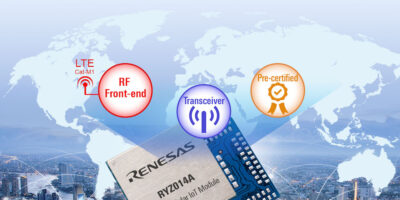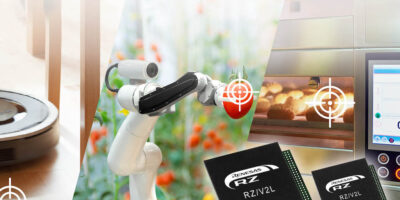Pre-tested and certified RYZ014A Cat-M1 cellular modules by Renesas are the company’s first cellular IoT modules to support the specification. Devices can directly connect to the internet using an existing communication infrastructure owned by mobile network operators, without the need for a gateway, says Renesas. This makes it economical to connect each device, which is beneficial when installing larger networks that require a low cost per unit.
To build a wireless IoT project from scratch, the RYZ014A module includes RF regulatory certification, PTCRB/GCF (network operators) certification and carrier certification for the customer’s network operator of choice.
The module has been certified with all major radio frequency regulations in the world as well as with leading network operators in North America, APAC and European countries.
The RYZ014A module is suitable for metering, smart home, infrastructure and industrial markets, where they can seamlessly interface Renesas microcontroller-based applications to the internet through their cellular network, for example Bluetooth Low Energy, Ultra-wide band (UWB) and Wi-SUN protocols.
Renesas has partnered with 4G and 5G chip and IoT module supplier, Sequans Communications, to provide the Monarch LTE CAT-M1 hardware and software technology used in the module.
Renesas offers customers a web-based portal, managed by ONE Tech, that provides easy access to read sensor values and manage SIM card plans remotely, reducing operating cost. ONE Tech’s embedded AI and cloud technology, with the Renesas CAT-M1 module offers embedded intelligence with an enterprise-grade platform, allowing customers to build, manage and scale smart machines in a cost-effective end-to-end ecosystem, says Renesas.
Support for world-wide frequency bands in a single design removes the need to create multiple customer platforms for different global regions, points out Renesas. There is also high output power supporting both power class options 20 and 23dBm and low current consumption in power saving mode of only 1.0 microA
The RYZ014A module and the RYZ014A-EVK evaluation kits are available now.
The RYZ014A modules can be combined with components from Renesas, such as power ICs, Li-ion battery charger, light-to-digital sensor, and RA family microcontrolelrs to create systems, such as remote industrial process monitoring and automatic plant watering with an LTE Connection.






